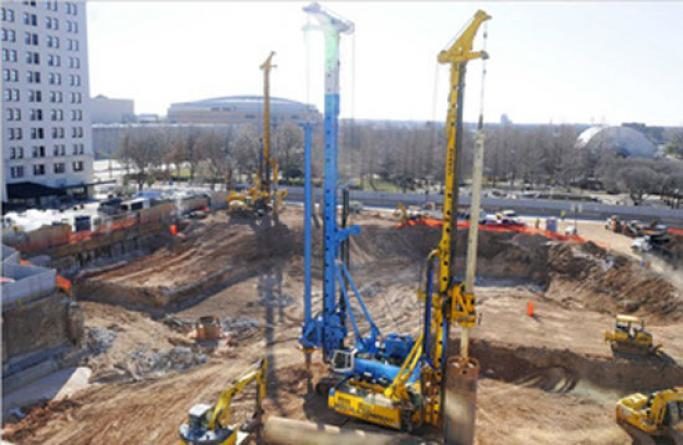Most companies have shelved expansion plans until the economy recovers — but not the Devon Energy Corporation, one of the country’s biggest independent energy companies.
Flush with cash from the energy boom, Devon broke ground in October for a 50-story tower in Oklahoma City that is among the tallest buildings under construction nationwide. The company’s new headquarters building will be the state’s tallest when it opens in 2012.
Despite the building’s $750 million price, Devon is betting the new tower will save money and make the company more efficient. All of its 1,500 employees in Oklahoma City, who are now scattered in five buildings around downtown, will be in a single location.
The building, designed by Pickard Chilton, will have 80,000 square feet of ground floor space with retail and food, open to the public. “It’s a great time to build a building. We can get it done faster and cheaper than during the boom,” said Larry Nichols, Devon’s chief executive. “We’re ahead of schedule and under budget.”
Devon’s building, however, is not the only construction project in Oklahoma City. In December, residents approved a $777 million tax package for a 70-acre central park, convention center, streetcar system, aquatic centers, boating facilities and trails that will be built over the next nine years.
A $140 million makeover of downtown, including new sidewalks, bicycle lanes and two-way streets, also starts in May courtesy of Devon.
“We’re assured of a 10-year economic stimulus plan,” said Roy H. Williams, chief executive of the Greater Oklahoma City Chamber.
While Devon’s tower is the only office building under construction, Oklahoma City’s commercial real estate market has been less affected than some markets by the downturn unfolding across the country. Rents and vacancy rates have not shown the wild swings that characterize other markets, although the vacancy rate was up to 20 percent at the end of the year, from 16.5 percent at the end of 2008, according to CB Richard Ellis, a commercial brokerage firm.
“We are still strongly dominated by the oil and natural gas industry. As long as it performs, we’re O.K.,” said Jim Austin, a vice president at CB Richard Ellis in Oklahoma City. “When everyone was tanking, we were doing well.”
Natural gas prices have skyrocketed over the last few years, bolstered by high energy demand and technological advances that opened up previously tapped fields, and climbed to more than $14 a thousand cubic feet in July 2008. Although the recession has depressed prices, they have started to recover as energy companies close wells and reduce drilling.
While Devon is making a contribution, much of the revival of downtown is being financed by taxpayers, who have a history of approving taxes to improve the city. In 1993, city voters approved a temporary one-cent increase in the sales tax to redevelop the riverfront, renovate the fairgrounds and build a ballpark, sports arena, library, trolley system, and a mile-long canal. For the next 15 years, residents have voted to continue paying for renovations on all the city’s public schools and the river.
“It’s pay as you go,” said Ronald J. Norick, who was Oklahoma City’s mayor from 1987 to 1998. “People can see where their money goes and what their money bought.”
After the collapse of the energy boom in the early 1980s, Oklahoma City struggled for well over a decade. Unemployment was around 10 percent, the only hotel downtown was on the verge of closing and the convention center’s roof leaked.
“Our city was dying. You could shoot a cannon at 5 p.m. and you wouldn’t hit anybody,” Mr. Norick said.
When Oklahoma City lost bids, in quick succession, for the maintenance hubs for United and American Airlines more than a decade ago, it decided to do something about it. When Mr. Norick visited Indianapolis, he saw a lively downtown full of hotels, restaurants, cafes and people on the streets and realized that companies were going elsewhere because Oklahoma City had “a dead downtown.”
Over the next year, Mr. Norick worked with a small group of people to come up with what would eventually become the city’s first taxpayer-financed project, or MAPS for Metropolitan Area Projects.
All the projects were placed downtown to attract new hotels, restaurants and other businesses.
“Initially, we took a city that was a nice place to live and raise a family, but was not a great place to visit,” said the current Oklahoma City mayor, Mick Cornett. “We’ve now created a city that we want to show off and we’re proud of.”
The projects have infused the city with a sense of enthusiasm and attracted more businesses downtown.
After a nationwide search, the American Automobile Association picked Oklahoma City for the site of its new customer service center because of its low business costs and vibrant economy, said Paula Downey, president of AAA Northern California, Nevada and Utah.
“What was most impressive about Oklahoma City was how well its various city departments worked together and followed through with us,” she said. “They’re a role model for other cities.”
Oklahoma City University is moving its law school downtown to be closer to the courthouse, legal agencies and law firms. When its $30 million renovation of a former Ford Motor factory is completed in two to three years, it will have doubled its space.
“We just want to be part of the downtown renaissance,” said Tom J. McDaniel, Oklahoma City University’s president.
Read more in the New York Times.
